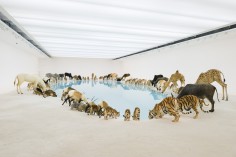CAI GUO-QIANG
蔡国强
Цай Го-Цян
Falling Back To Earth

source: arrestedmotion
Commissioned specifically for this museum showing will be a new sculptural piece entitled Heritage 2013 featuring 99 animals from around the world gathering at a watering hole, reflecting on his thoughts about nature and globalization. Along with this centerpiece, other new works inspired by Cai’s time in Australia will accompany Head On, his famous stream of life-sized wolves leaping through the air and crashing into a glass wall. This show marks a renewed focus on the Earth after a recent exhibition in Los Angeles (covered) featuring his fascination with the otherworldly (i.e.: aliens).
.
.
.
.
.
.
.
source: theastonishingpost
Artist Cai Guo-Qiang is going to create a brand new installation that, no doubt, will have everyone talking. Called Heritage 2013, it will be the epic centerpiece of an exhibition coming to Queensland’s Gallery of Modern Art (GOMA) from November 23, 2013 to April 21, 2014. Gathered together around a watering hole will be 99 life-sized artificial wild animals from around the world. The huge installation is meant for us to reflect on our relationship with nature as well as how we relate to each other in this time of globalization.
The Chinese contemporary artist, who most recently made headlines his explosive, otherworldly works, has decided to turn his attention away from the universe and, instead, look more closely at the Earth, our common home. Hence, the upcoming exhibition will be called “Cai Guo-Qiang: Falling Back to Earth.”
In addition to Heritage 2013, Guo-Qiang will bring back his 2006 work Head On, which features 99 life-sized artificial wolves configured as a large group, leaping into the air before crashing into a glass wall. The thought-provoking work asks viewers to reflect upon mankind’s destiny to repeat its mistakes.
.
.
.
.
.
.
source: caiguoqiang
Cai Guo-Qiang was born in 1957 in Quanzhou City, Fujian Province, China. Trained in stage design at the Shanghai Theater Academy, his work has since crossed multiple mediums within art, including drawing, installation, video and performance art. While living in Japan from 1986 to 1995, he explored the properties of gunpowder in his drawings, an inquiry that eventually led to his experimentation with explosives on a massive scale and to the development of his signature explosion events. Drawing upon Eastern philosophy and contemporary social issues as a conceptual basis, these projects and events aim to establish an exchange between viewers and the larger universe around them, utilizing a site-specific approach to culture and history. He currently lives and works in New York.
Cai was awarded the Japan Cultural Design Prize in 1995 and the Golden Lion at the 48th Venice Biennale in 1999. In the following years, he has received the 7th Hiroshima Art Prize (2007), the 20th Fukuoka Asian Culture Prize (2009), and AICA’s first place for Best Project in a Public Space for Cai Guo-Qiang: Fallen Blossoms (2010). He also curated the first China Pavilion at the 51st Venice Biennale, 2005, and held the distinguished position as Director of Visual and Special Effects for the opening and closing ceremonies of the 2008 Summer Olympics in Beijing. In 2012, Cai was honored as one of five Laureates for the prestigious Praemium Imperiale, an award that recognizes lifetime achievement in the arts in categories not covered by the Nobel Prize. Additionally, he was also among the five artists who received the first U.S. Department of State – Medal of Arts award for his outstanding commitment to international cultural exchange.
Among his many solo exhibitions and projects include Cai Guo-Qiang on the Roof: Transparent Monument, Metropolitan Museum of Art, New York, 2006 and his retrospective I Want to Believe, which opened at the Solomon R. Guggenheim Museum, New York in February 2008 before traveling to the National Art Museum of China in Beijing in August 2008 and then to the Guggenheim Bilbao in March 2009. In 2011, Cai appeared in the solo exhibition Cai Guo-Qiang: Saraab at Mathaf: Arab Museum of Modern Art in Doha, Qatar, his first ever in a Middle Eastern country.
In 2012, the artist appeared in three solo exhibitions: Cai Guo-Qiang: Sky Ladder (Museum of Contemporary Art, Los Angeles), Cai Guo-Qiang: Spring (Zhejiang Art Museum, Hangzhou, China), and A Clan of Boats (Faurschou Foundation, Copenhagen, Denmark). His first ever solo exhibition in Brazil, Cai Guo-Qiang: Da Vincis do Povo, is currently on view in Brasilia at the Centro Cultural Banco do Brasil and Museu dos Correios. A three-city exhibition, Da Vincis do Povo will also travel to São Paulo and Rio de Janeiro in spring and fall 2013. His next exhibition, Cai Guo-Qiang: Falling Back to Earth will open November 2013 at the Queensland Art Gallery | Gallery of Modern Art in Australia.
.
.
.
.
.
.
source: glanceit
O artista chinês Cai Guo Quiang nasceu em Quanzhou, no sudeste da China, morou no Japão e atualmente vive em Nova York. O artista trousse grandes painéis produzidos com materiais como pólvora, aviões, naves e grandes instalações além de ter feito homenagem a artistas como Yves Klein (que “inventou o azul Klein”). Parte das obras foi produzida em colaboração com artistas amadores, gente do povo, daí o nome da mostra.
Algumas peças da exposição podem ser apreciadas nas próprias ruas ao redor do Centro Cultural Banco do Brasil (onde acontece a exposição). Um dos objetivos de Cai Guo-Qiang é interferir com o dia a dia da metrópole e provocar as pessoas que circulam pelo centro da cidade.
Cai Guo-Qiang ganhou um Leão de Ouro na Bienal de Veneza, em 1999, além de ter desenhado os efeitos pirotécnicos das cerimônias de abertura e encerramento das Olimpíadas de Pequim, em 2008. Formado em cenografia pela Academia de Teatro de Xangai, o artista explora bastante o espaço, aproveitando-se dos artefatos tecnológicos para encorpar as ideias e levar o público ao “estado de sonho” que deseja.

